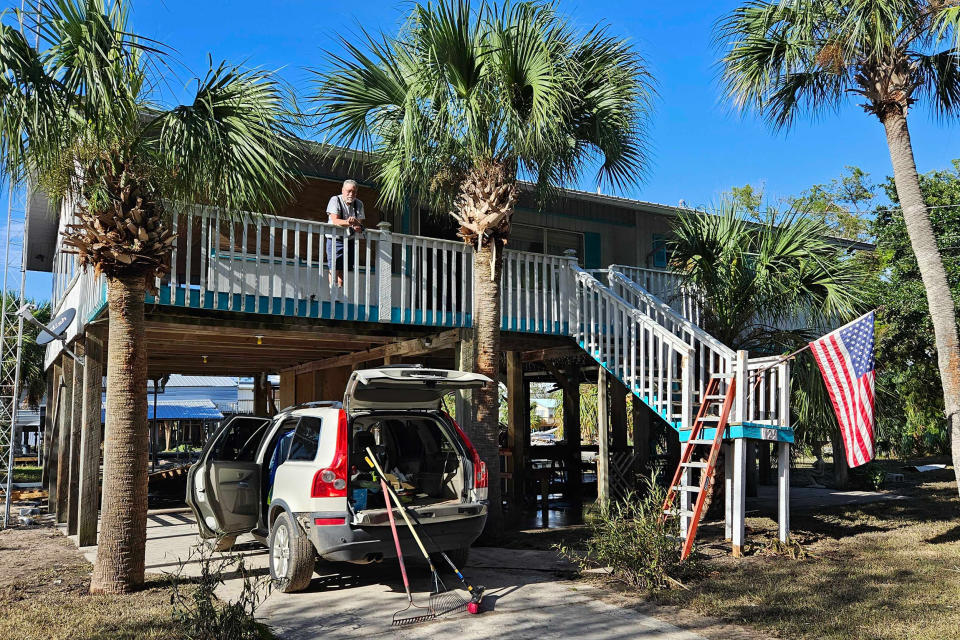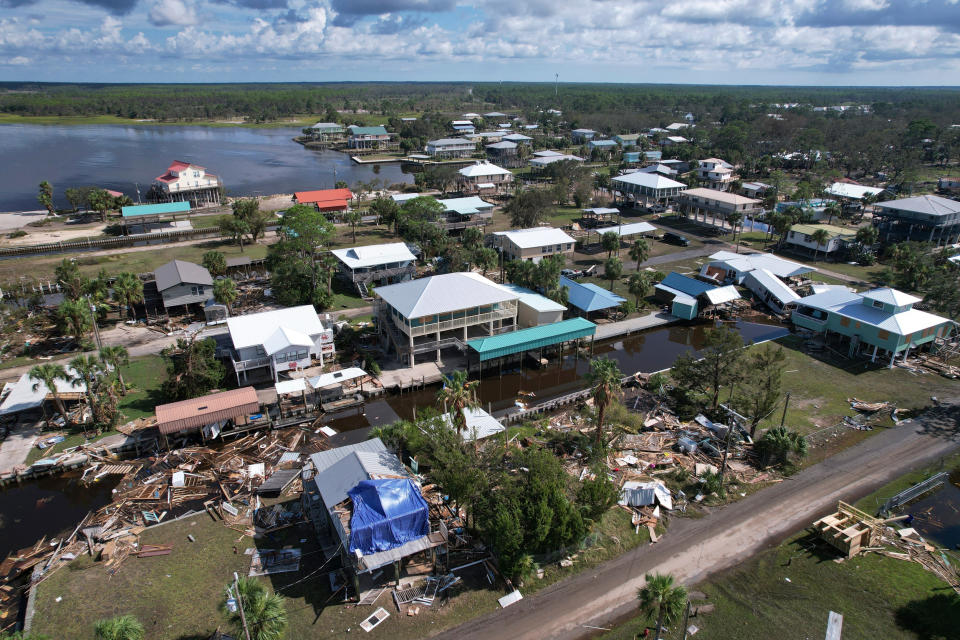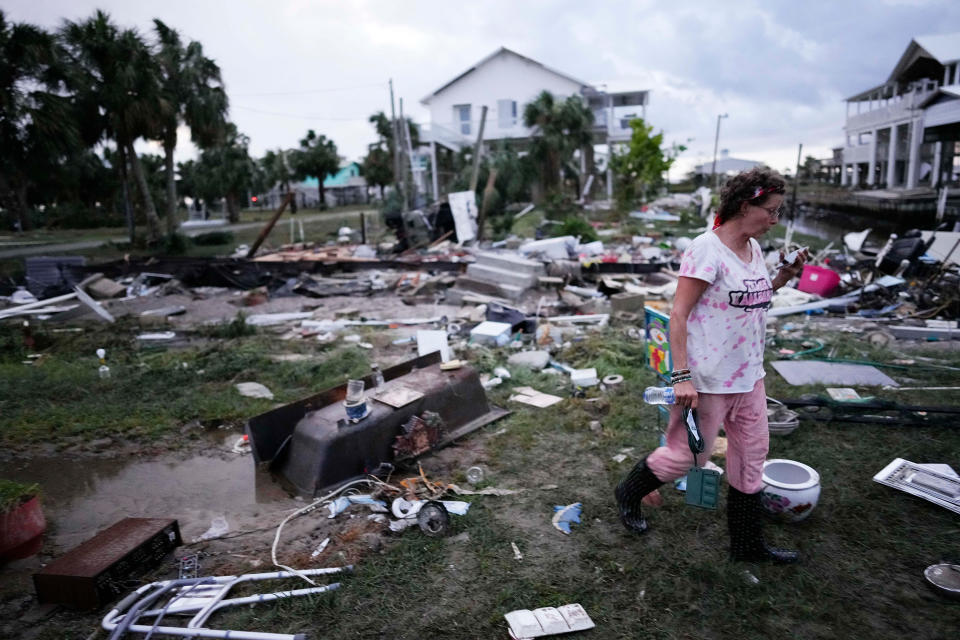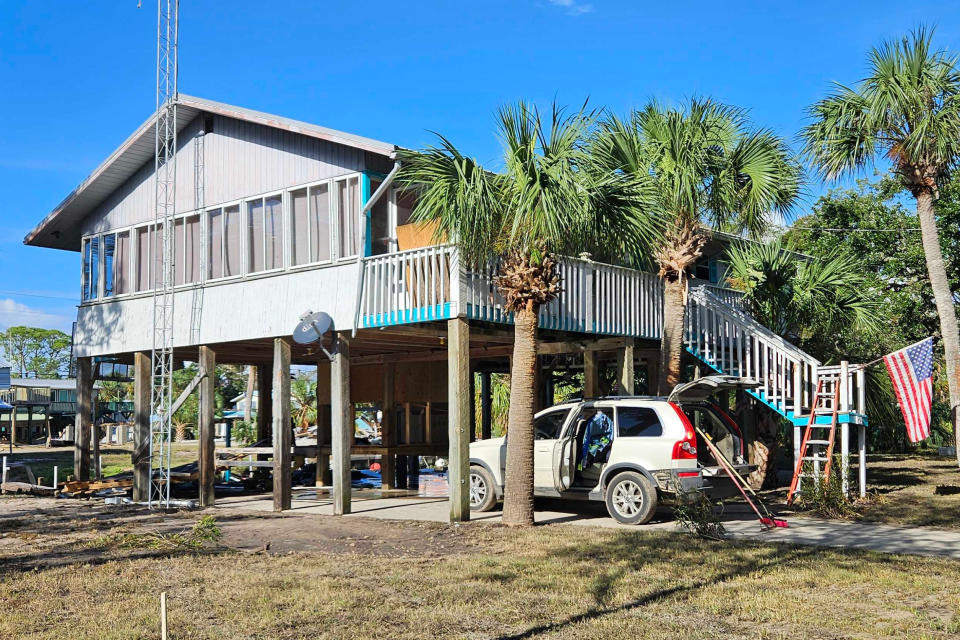Why Hurricane Idalia's destruction skipped some homes along Florida's coast
HORSESHOE BEACH, Fla. — Hurricane Idalia ravaged the isolated fishing village of Horseshoe Beach, leaving it a community of contrasts: Dozens of modest homes along the Big Bend coast were heavily damaged in the floodwaters, but interspersed among the debris were residences left relatively unscathed, all because they were built elevated on stilts.
"This home is a survivor," Sparky Abrandt, 78, said Thursday as he surveyed the wrecked landscape from his teal-trimmed house, which remained perched 13 feet off the ground.
But he could see other homeowners were not so fortunate after a 10-foot wall of water roared through the neighborhood.
"To me, it's luck my house is here," said Abrandt, a former New Yorker who moved to the area five years ago. "Right now, I'm happy that the house was saved."

State officials and home building experts contend it's not so much luck as regularly revised state building codes that allow certain homeowners to dodge total destruction. As the frequency and severity of catastrophic weather events linked to rising global temperatures underscore the urgency, a delicate balance must be struck between building stronger and considering income disparities and the preservation of local culture.
"You'll have people who argue, 'If you make new codes, I can't afford to upgrade and I can't afford to live here, so just let me put it back the way it was,'" said Craig Fugate, Federal Emergency Management Agency administrator during the Obama administration.
"But then maybe you'll have developers coming in, willing to buy distressed properties," said Fugate, who lives in north Florida. "Those people might sell out, and then what becomes of the community? This will be a debate."
It's one that could crop up in places such as the Hawaiian island of Maui, where deadly wildfires last month ripped through the historic seaside town of Lahaina and leveled homes, and in Horseshoe Beach, a community of roughly 170 people that has lured curious visitors as "Florida's Last Frontier."
Idalia, which made landfall early Wednesday about 30 miles north of Horseshoe Beach with maximum sustained winds of 125 mph, toppled trees and flooded homes across the Gulf Coast region. At least three people were killed in Florida. It also brought heavy rains and winds to Georgia and other East Coast states before moving out to sea Friday as a post-tropical cyclone.

But as cleanup continues, builders in Florida surveying the damage said the fact that not every home was wiped out, even in places hit as hard as Horseshoe Beach, is significant.
"No question that the codes work," said Don Brown, a member of the Florida Building Commission and a former legislator from the Panhandle. "They provide both life safety and reduce destruction of property. Having said that, there's always room for improvement."
After Hurricane Andrew clobbered South Florida in 1992, the state moved to tighten its building codes away from a patchwork of local rules and into a universal standard.
The codes are revised every three years, with the eighth edition to go into effect Dec. 31.
Knowledge gained from each hurricane can be incorporated in the next round of changes, and Idalia may offer its own lessons for reinforcing the rules, said Mike Silvers, director of technical services at the Florida Roofing and Sheet Metal Contractors Association.
"The code in Florida is pretty stringent," he said. "You don't have to immediately go back and do things because the law changed, but there are triggers within the law that do create things that should be done."
After Hurricane Michael struck the Florida Panhandle in 2018 as a Category 5 storm, Silvers said, he looked at the damage in the Panama City area and noticed how even older homes fared better if they had been reroofed with another layer to protect against water.
The aftermath of Idalia also made it clear that homes elevated on pilings were protected from the storm surge.
"Even from the aerial shots, you can see if you look at a particular road or along a canal, you might see homes that have been beat up and others that have survived very well," Silvers said. "So when you pull the building permits to see why, seldom are we surprised that it's the newer ones built to higher standards that are standing out from the others."

But elevating an already existing home can cost in the tens of thousands of dollars, a daunting expense for homeowners with older residences.
"If you’ve got a home in Cedar Key and it was built in the '50s and it's on the ground, to raise that home is a big deal," Brown said. "And if it's built on a slab foundation, you can't even raise it."
Homeowners may grow complacent if they live in areas not normally prone to major storms or flooding, Brown said, but hurricanes like Idalia, which was the strongest to make landfall in the Big Bend region in more than 125 years, should be a wakeup call.
For those whose homes were destroyed, grants to rebuild may be available through FEMA and the federal Department of Housing and Urban Development, but depending on where applicants live, they could be faced with upgrades that include adhering to the stricter building codes and insurance requirements.
Fugate said the idea of people in communities like Horseshoe Beach being able to rebuild and maintain their way of life — untouched by strip malls and high-rise developments — is an idyllic prospect.
It happened before, when the "storm of the century," according to the National Weather Service, slammed into the Big Bend region in 1993.
But Idalia may prove to be a turning point.
"Thinking we're going to put it back the way it was and not change it, that's a really optimistic viewpoint," Fugate said. "The challenges are real, especially for those who didn't have insurance."

Abrandt, whose home happened to be constructed on stilts when he bought it, is counting his blessings. He lost an area below his home that he had remodeled to include an outdoor bar and a television mounted on the wall.
He had hosted gatherings there for his friends and neighbors with drinks flowing and bands playing as the sun dipped below the horizon.
"We don't need all the tourists," Abrandt said, adding, "This is a simple life."
Minyvonne Burke reported from Horseshoe Beach, and Erik Ortiz from New York.
This article was originally published on NBCNews.com

